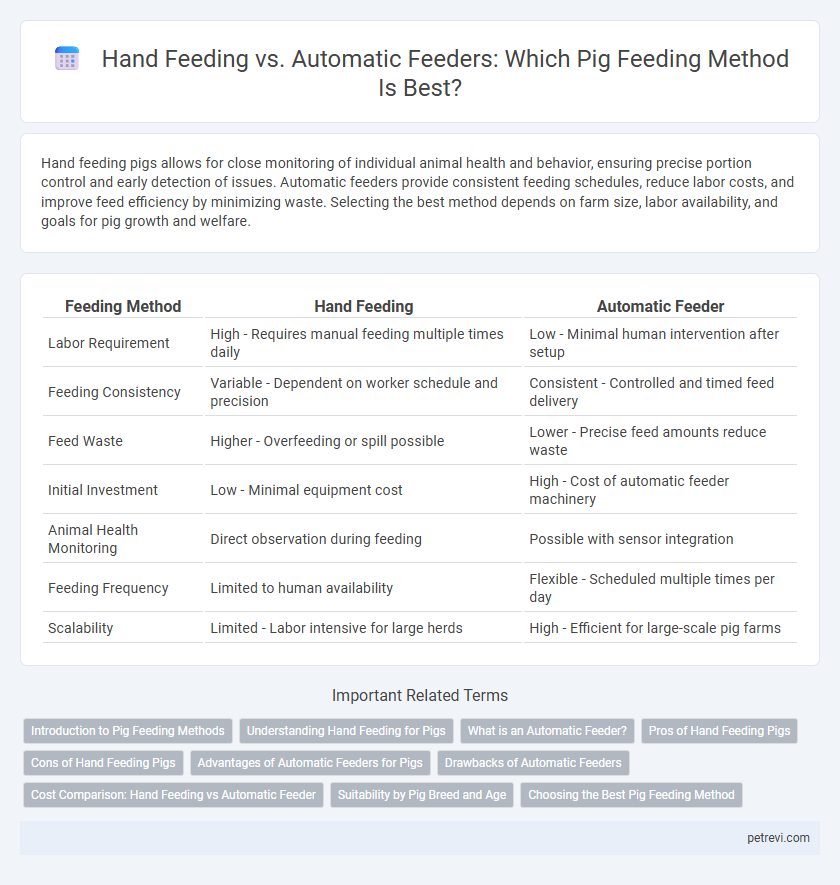Hand feeding pigs allows for close monitoring of individual animal health and behavior, ensuring precise portion control and early detection of issues. Automatic feeders provide consistent feeding schedules, reduce labor costs, and improve feed efficiency by minimizing waste. Selecting the best method depends on farm size, labor availability, and goals for pig growth and welfare.
Table of Comparison
| Feeding Method | Hand Feeding | Automatic Feeder |
|---|---|---|
| Labor Requirement | High - Requires manual feeding multiple times daily | Low - Minimal human intervention after setup |
| Feeding Consistency | Variable - Dependent on worker schedule and precision | Consistent - Controlled and timed feed delivery |
| Feed Waste | Higher - Overfeeding or spill possible | Lower - Precise feed amounts reduce waste |
| Initial Investment | Low - Minimal equipment cost | High - Cost of automatic feeder machinery |
| Animal Health Monitoring | Direct observation during feeding | Possible with sensor integration |
| Feeding Frequency | Limited to human availability | Flexible - Scheduled multiple times per day |
| Scalability | Limited - Labor intensive for large herds | High - Efficient for large-scale pig farms |
Introduction to Pig Feeding Methods
Hand feeding allows precise control over pig nutrition and portion size, promoting optimal growth and health monitoring. Automatic feeders improve efficiency by delivering consistent feed quantities and reducing labor costs in large-scale farming operations. Both methods impact feed intake regulation, growth performance, and farm management practices.
Understanding Hand Feeding for Pigs
Hand feeding pigs allows for precise control over individual pig nutrition and health monitoring, ensuring tailor-made feeding strategies for optimal growth. This method facilitates early detection of illness or feeding issues, promoting better welfare and reducing mortality rates. Although labor-intensive, hand feeding enhances the ability to adjust diets based on pig age, weight, and production stage, thereby maximizing feed efficiency.
What is an Automatic Feeder?
An automatic feeder for pigs is a mechanical device designed to dispense precise quantities of feed at scheduled intervals, ensuring consistent nutrition and reducing labor costs. These feeders use sensors or programmable timers to control feed delivery, optimizing growth rates and minimizing waste. Automatic feeders also help maintain hygienic feeding conditions by limiting feed exposure and preventing overfeeding.
Pros of Hand Feeding Pigs
Hand feeding pigs allows for precise portion control and immediate health monitoring, enabling farmers to adjust diets based on individual pig needs and detect illnesses early. This method fosters stronger human-animal interaction, improving pig calmness and ease of handling during routine care. Moreover, hand feeding reduces the risk of feeder malfunctions and feed wastage, ensuring efficient use of resources and maintaining consistent feeding schedules.
Cons of Hand Feeding Pigs
Hand feeding pigs is labor-intensive, requiring constant time and attention, which increases labor costs significantly. It risks inconsistent feeding schedules and amounts, leading to uneven growth rates and potential health issues among the herd. Manual feeding methods also limit the ability to monitor individual pigs' intake accurately, reducing overall feeding efficiency and farm productivity.
Advantages of Automatic Feeders for Pigs
Automatic feeders for pigs enhance feeding efficiency by delivering precise portions tailored to individual growth stages, reducing feed wastage and promoting consistent nutrient intake. These systems improve herd health by minimizing human contact and stress, which can lower the risk of disease transmission. Additionally, automatic feeders enable real-time monitoring and data collection, facilitating optimal feed management and productivity in pig farming operations.
Drawbacks of Automatic Feeders
Automatic feeders for pigs often face challenges such as mechanical malfunctions leading to inconsistent feed delivery and increased maintenance costs. These systems can also limit the ability to monitor individual pig feeding behavior, potentially causing nutritional imbalances or unnoticed health issues. Furthermore, automatic feeders may encourage overfeeding or feed wastage, negatively impacting farm efficiency and profitability.
Cost Comparison: Hand Feeding vs Automatic Feeder
Hand feeding pigs typically incurs higher labor costs due to the need for continuous human involvement, while automatic feeders require significant initial investment but reduce long-term expenses by minimizing manual labor. Automatic feeders also lower feed wastage through precise portion control, resulting in better cost efficiency over time compared to hand feeding. Evaluations of pig farming operations indicate that automatic feeders can reduce overall feeding costs by up to 25% when deployed on medium to large-scale farms.
Suitability by Pig Breed and Age
Hand feeding allows precise control over diet tailored to pig breed and age, ensuring sensitive piglets or specific breeds receive appropriate nutrition. Automatic feeders provide consistent feed access ideal for uniform breeds and older pigs with stable eating patterns. Selecting between methods depends on growth stages, breed-specific dietary needs, and labor availability for optimal pig health and growth performance.
Choosing the Best Pig Feeding Method
Hand feeding pigs allows for precise control over individual nutrition and easy monitoring of animal health but requires intensive labor and time. Automatic feeders offer consistent feed distribution, reduced labor costs, and improved growth rates due to steady access to feed, making them ideal for large-scale operations. Choosing the best pig feeding method depends on farm size, labor availability, and specific nutritional management goals to maximize productivity and animal welfare.
Hand feeding vs Automatic feeder for Pig feeding method Infographic

 petrevi.com
petrevi.com